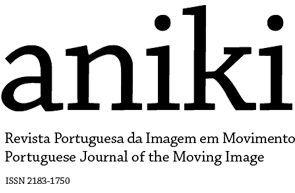Bill Viola’s 'Nantes Triptych': Unearthing the sources of its condensed temporality
Resumen
In this text we intend to analyze Bill Viola’s video installation Nantes Triptych (1992) as an example of the richness which lies in the liminal spaces between arts. We defend the thesis that the utilization of the traditional pictorial structure of the triptych in this particular work, along with the powerful audiovisual material, renders a kairological event available to the viewer. This temporal experience makes possible an existential experience when in front of this video installation. To discuss this assumption we will use classical art theory texts about the triptychs, as well as, among others, Deleuze’s texts about time image and the triptych structure, Agamben’s concept of kairos, the concept of kairological artwork coined by David Chan and the philosophy of temporality developed by Merleau-Ponty.
Citas
Agamben, Giorgio. 1999. “Aby Warburg and the Nameless Science”, in Potentialities: Collected Essays in Philosophy, trans. and ed. by Daniel Heller-Roazen. Stanford: Stanford University Press, 89-103.
Agamben, Giorgio. 2005. The Time That Remains: A Commentary on the Letter to the Romans, transl. by Patricia Dailey. Stanford: Stanford University Press.
Agamben, Giorgio. 2011. “Nymphs”, in Releasing the Image: From Literature to New Media. ed. by Jacques Khalip and Robert Mitchell. Stanford: Stanford University Press, 60-80.
Barker, Timothy Scott. 2012. Time and the Digital: connecting technology, aesthetics, and a process philosophy of time. Hannover, Dartmouth College Press.
Bernardini, Anna (ed.). 2012. Bill Viola Reflections. Milan: Silvana Editoriale.
Chan, Paul. 2010. “A Time Apart”, in Greater New York, ed. by Klaus Biesenbach. New York, MoMA PS1: 84-85.
Deleuze, Gilles. 1989. Cinema 2 The Time-Image, trans. by Hugh Tomlinson and Robert Galeta. Minneapolis: University of Minnesota Press.
Deleuze, Gilles. 2003. Francis Bacon the logic of sensation, trans. by Daniel W. Smith. New York: Continuum, 2003.
Gayford, Martin. 2003. “The Ultimate Invisible World: Interview with Bill Viola”, Modern Painters, 16: 22-25.
Guzman, Alissa. 2009. “Conversation with Bill Viola”, Whitehot Magazine, December. http://www.whitehotmagazine.com/articles/in-conversation-with-bill-viola/1979.
Hansen, Mark. 2004. “The Time of Affect, or Bearing Witness to Life”. Critical Inquiry, 30: 3, 584-626.
Heartney, Eleanor. 2002. “Video Installation and the Poetics of Time," in Outer & Inner Space ed. by John B. Ravenal. Virginia: Museum of Fine Arts, 14-21.
Jacobs, Lynn. 2012. Opening Doors: The Early Netherlandish Triptych Reinterpreted. Pennsylvania: Penn State University Press.
Lankheit, Klaus. 1959. Das Triptychon als Pathosformel, Heildeberg: Carl Winter Universitätsverlag.
Leston, Robert. 2013. “Unhinged: Kairos and the Invention of the Untimely”, Atlantic Journal of Communication, 21: 1, 29-50.
Manchester, Elizabeth. 2000. “Nantes Triptych.” TATE, accessed June 17, 2014, http://www.tate.org.uk/art/artworks/viola-nantes-triptych-t06854.
Mennekes, Friedhelm. 1999. “Nantes Triptych”, in Bill Viola Europäische Einsichten | European Insights, ed. by Rolf Lauter. Munich: Prestel Verla: 223-234.
Merleau-Ponty, Maurice. 2005. Phenomenology of Perception. Trans. by Colin Smith. New York: Routledge Classics.
Neumaier, Otto. 2004. “Space, time, video, Viola”, in The Art of Bill Viola, ed. by Chris Townsend. London: Thames & Hudson, 46-71.
Rush, Michael. 2005. New Media in Art. London: Thames & Hudson, 2005.
Smith, John. E. 1969. “Time, Times, and the 'Right Time'; Chronos and Kairos”, The Monist, 53(1): 1-13.
Townsend, Chris (ed.). 2004. The Art of Bill Viola. London: Thames & Hudson.
Viola, Bill. 1995. Reasons for Knocking at an Empty House. Writings 1973-1994, ed. Robert Violette, introduction of Jean-Christophe Amman. London: Thames & Hudson.
Viola, Bill. 2003. “The John Tusa Interview with Bill Viola.” 45 minutes. BBC Radio 3, London.
Walsh, John (ed.) 2003. “Emotions in Extreme Time: Bill Viola’s Passions Project,” in Bill Viola: The Passions. Los Angeles: J. Paul Getty Museum in association with the National Gallery.





